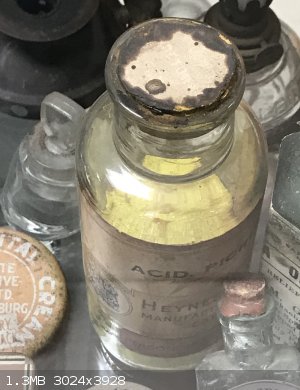froot
Hazard to Others
  
Posts: 347
Registered: 23-10-2003
Location: South Africa
Member Is Offline
Mood: refluxed
|
|
Chemical anomalies in the public space.
It would be interesting to see what bizarre chemicals people encounter from time to time in their daily routines so I thought I'd start a topic on it.
If there is already one I obviously did not find it and forgive me and please merge this to the older one.
As a thread starter I thought I'd share this:
I went to a chemist in town last week and outside their shop they had a rather nice display of antique medicines. While looking through this
collection I was shocked to find a bottle of picric. I have no idea how that could've been medically relevant or weather the collection owner was
ignorant or just testing to see if anyone would notice it. I'm not expecting the latter, this is not a very intellectual town. The lady at the till
acknowledged that it was their collection and why? In response I simply said I found it quite interesting and left.
I showed a few friends and family these photos but to my dismay they didn't seem to appreciate my find as much as some people here would so here it
is.
  
We salute the improvement of the human genome by honoring those who remove themselves from it.
Of necessity, this honor is generally bestowed posthumously. - www.darwinawards.com |
|
|
fusso
International Hazard
    
Posts: 1922
Registered: 23-6-2017
Location: 4 ∥ universes ahead of you
Member Is Offline
|
|
Why didn't you ask whether you can buy it from them or not?
|
|
|
froot
Hazard to Others
  
Posts: 347
Registered: 23-10-2003
Location: South Africa
Member Is Offline
Mood: refluxed
|
|
I don't need any. If I did I'd much rather synthesize it.
We salute the improvement of the human genome by honoring those who remove themselves from it.
Of necessity, this honor is generally bestowed posthumously. - www.darwinawards.com |
|
|
morganbw
National Hazard
   
Posts: 561
Registered: 23-11-2014
Member Is Offline
Mood: No Mood
|
|
It is sad to me that the word picric raises eyebrows.
|
|
|
unionised
International Hazard
    
Posts: 5128
Registered: 1-11-2003
Location: UK
Member Is Offline
Mood: No Mood
|
|
Picric acid was used as a burn medication.
It's probably real.
The interesting question is ; should someone warn the owner?
I think they should.
|
|
|
Assured Fish
Hazard to Others
  
Posts: 319
Registered: 31-8-2015
Location: Noo Z Land
Member Is Offline
Mood: Misanthropic
|
|
Is the pircric acid stored under water?
Its hard to tell but its only sensitive if its dry if im not mistaken.
Sufficiently advanced science is indistinguishable from madness.
|
|
|
BromicAcid
International Hazard
    
Posts: 3253
Registered: 13-7-2003
Location: Wisconsin
Member Is Offline
Mood: Rock n' Roll
|
|
Picric acid was used in a lot of formulations for its antibacterial properties. Storing under water is a fairly new introduction on storage, so is
storing in plastic bottles. Picric acid itself isn't remarkably friction or shock sensitive. It was the metal picrates formed in the caps of some of
these old bottles that were the real trouble makers.
|
|
|
VSEPR_VOID
National Hazard
   
Posts: 719
Registered: 1-9-2017
Member Is Offline
Mood: Fullerenes
|
|
I would be worried about it drying out
Within cells interlinked
Within cells interlinked
Within cells interlinked
|
|
|
Herr Haber
International Hazard
    
Posts: 1236
Registered: 29-1-2016
Member Is Offline
Mood: No Mood
|
|
By the color I'd say no. Dry picric acid looks a bit like sulphur depending on cristal size.
I'm not too keen on crying wolf but in this case I think the owner should be warned. Just to avoid possible complications if someone else spots this
and reacts... differently.
|
|
|
AJKOER
Radically Dubious
    
Posts: 3026
Registered: 7-5-2011
Member Is Offline
Mood: No Mood
|
|
My recollection having once owned some picric acid (which was somewhat moist) was that I was surprised to learn how small a lethal dose is (highly
poisonous if taken internally). In other words, proper disposal is a must, one cannot just throw it away.
Yes, it was used in the treatment of burns.
----------------------------------------------------
On a train trip I was surprised to see many chemical container railroad cars that have just numbers, and no indication of what industrial compound was
being transported.
So, in the event of some accident, one may not know in a timely fashion as to exactly what chemical agent was spilled or was being heated in a fire.
Now, that may not be necessary if the chemical by itself is relatively safe, but a chemist knows that some chemicals just don't mix well with others
forming potentially some very problematic products (like a NH4+ salt and an alkaline aqueous hypochlorite).
[Edited on 5-11-2018 by AJKOER]
|
|
|
j_sum1
Administrator
       
Posts: 6335
Registered: 4-10-2014
Location: At home
Member Is Offline
Mood: Most of the ducks are in a row
|
|
Quote: Originally posted by AJKOER  |
Now, that may not be necessary if the chemical by itself is relatively safe, but a chemist knows that some chemicals just don't mix well with others
forming potentially some very problematic products |

[Edited on 5-11-2018 by j_sum1]
|
|
|
unionised
International Hazard
    
Posts: 5128
Registered: 1-11-2003
Location: UK
Member Is Offline
Mood: No Mood
|
|
Judging by the style of the bottle it's a good 50 years old.
As far as I can tell, it's sealed with a cork.
Even if it was wet once, it won't be now.
I'd say this was a bomb squad job unless someone in the store can assure you that they got an old empty bottle + filled it with yellow paint.
|
|
|
S.C. Wack
bibliomaster
    
Posts: 2419
Registered: 7-5-2004
Location: Cornworld, Central USA
Member Is Offline
Mood: Enhanced
|
|
Services Textbook (1972): Picric acid (Chapter 6) is now unlikely to be met with in the British Service, although it was used as a pressed filling
for shell from about 1890 until the 1914-18 War. Also known in the Service as Lyddite (after the site in Kent where early experimental work was done
on shell filled with picric acid), it was considered very suitable for armour-piercing shell as it would withstand the shock on impact or
penetration before being subsequently exploded by the fuze system.
Bretherick's (2007): The first high explosive shock-resistant enough to find use in shells. Most of its salts are more sensitive.
Alone, or Heavy metals, or Bases
1. Cooper-Key, A., Home Office Rept. 211, 9, HMSO, 1914
2. Kirk-Othmer, 1965, Vol. 8, 617
3. Urbanski, 1964, Vol. 1, 518
4. Garey, H. E., Chem. Eng. News, 1979, 57(41), 51
5. Ventrone, T. A., CHAS Notes, 1982, 1(3), 1—2; (4), 4
6. Mendenhall, G. D., Chem. Eng. News, 2005, 83(6), 5
Picric acid, in common with several other polynitrophenols, is an explosive material in its own right and is usually stored as a water-wet paste.
Several dust explosions of dry material have been reported [1]. It forms salts with many metals, some of which (lead, mercury, copper or zinc) are
rather sensitive to heat, friction or impact. The salts with ammonia and amines, and the molecular complexes with aromatic hydrocarbons, etc. are, in
general, not so sensitive [2]. Contact of picric acid with concrete floors may form the friction-sensitive calcium salt [3]. Contact of molten picric
acid with metallic zinc or lead forms the metal picrates which can detonate the acid. Picrates of lead, iron, zinc, nickel, copper, etc. should be
considered dangerously sensitive. Dry picric acid has little effect on these metals at ambient temperature. Picric acid of sufficient purity
is of the same order of stability as TNT, and is not considered unduly hazardous in regard to sensitivity [4]. Details of handling and
disposal procedures have been collected and summarised [5]. Once a reagent found in most laboratories, it now excites undue fear; in reaction to an
ill-informed safety officer’s demand for removal or destruction of a bottle of the wet solid, one chemist introduced synthesis and drop-weight
detonation tests into a university teaching course. It seldom or never detonated, while dibenzoyl peroxide, sold to the public in concentrated form as
a resin hardener, always did. (The safety officiouser was satisfied by a certificate alleging that the wet acid had been converted to perhaps more
dangerous dry picryl chloride) [6]. Subsequent editions of the journal are loud with the protests of ‘Safety Professionals.’
...now say it a different way:
Laboratory Safety for Chemistry Students (2016): ...when picric acid reaches a dry state it has the same potential as TNT to be
explosive. If a bottle if picric acid is found to be dry or to have dried crystals around the cap, it should not be handled...
...a rifle bullet will not detonate TNT.
[Edited on 6-11-2018 by S.C. Wack]
|
|
|
j_sum1
Administrator
       
Posts: 6335
Registered: 4-10-2014
Location: At home
Member Is Offline
Mood: Most of the ducks are in a row
|
|
Maybe this is off topic, but how many energetic materials also have a medical use?
There's picric acid and nitroglycerine. What else?
Expolsive/medical always seemed an odd combo.
|
|
|
Cezium
Harmless

Posts: 39
Registered: 5-1-2015
Member Is Offline
Mood: No Mood
|
|
Not exactly an energetic but KClO4 (brand name "Chlorigen") to block thyroid and CNS Na/I symporter.
en.wikipedia.org/wiki/Potassium_perchlorate#Medicine_use
|
|
|
phlogiston
International Hazard
    
Posts: 1379
Registered: 26-4-2008
Location: Neon Thorium Erbium Lanthanum Neodymium Sulphur
Member Is Offline
Mood: pyrophoric
|
|
Potassium chlorate must also have a pharmaceutical use, because I used to be able to buy it (decades ago) from a very small local pharmacy. They would
not keep an inventory of chemicals only for little boys interested in chemistry. Also, the staff only knew it by its Latin name 'kalii chloras'.
Not exactly medical use, but picric acid and dinitrophenylhydrazine are used in clinical diagnostic laboratories a lot, respectively to assay
creatinine in urine, and for assaying various ketones and aldehydes
[Edited on 7-11-2018 by phlogiston]
-----
"If a rocket goes up, who cares where it comes down, that's not my concern said Wernher von Braun" - Tom Lehrer |
|
|